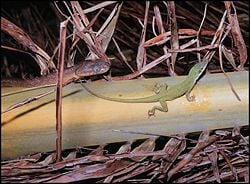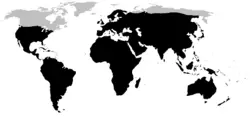Difference between revisions of "Squamata" - New World Encyclopedia
Rick Swarts (talk | contribs) |
Rick Swarts (talk | contribs) |
||
| Line 18: | Line 18: | ||
}} | }} | ||
| − | '''Squamata''' (scaled reptiles) is the most diverse order of [[reptile]]s, comprised of the [[lizard]]s and [[snake]]s and characterized a flexible jaw structure (movable [[quadrate bone]]s). | + | '''Squamata''' (scaled reptiles) is the most diverse order of extant [[reptile]]s, comprised of the [[lizard]]s and [[snake]]s and characterized a flexible jaw structure (movable [[quadrate bone]]s) and having [[scale (zoology)|scales]] or shields rather than shells or secondary palates. Of the four surviving orders—the others being [[Crocodilia]], [[Tuatara|Rhynchocephalia]], and [[Turtle|Testudines]]—the squamates represent more than 95% of the known living species (Uetz 2000). |
| − | + | ==Overview== | |
| + | Reptiles are tetrapods (four-legged [[vertebrate]]s) and amniotes ([[animal]]s whose embryos are surrounded by an amniotic membrane that encases it in amniotic fluid). Reptiles have traditionally been defined as including all the amniotes except [[bird]]s and [[mammal]]s. | ||
| + | Today, reptiles are represented by four surviving orders: | ||
| + | * '''[[Squamata]]''' (lizards, snakes, and amphisbaenids ("worm-lizards") | ||
| + | * '''[[Crocodilia]]''' (crocodiles, caimans, and alligators) | ||
| + | * '''[[Tuatara|Rhynchocephalia]]''' (tuataras from [[New Zealand]]) | ||
| + | * '''[[Turtle|Testudines]]''' (turtles) | ||
| + | According to Uetz (2000), there are a total of 7,870 [[species]] of reptiles, with the majority being [[lizard]]s (4,470 species) and [[snake]]s (2,920), and with 156 [[amphisbaenia]]s, 23 described species of living crocodiles, 295 species of turtles, and 2 species of tuataras. Similarly, Grzimet et al. (2004) note 1,440 genera and 4,450 species of lizards and 440 genera and 2, 750 species of snakes. In all, this means that almost 96% of living reptiles belong to the Squamata order. | ||
| + | Squamata is considered to be a natural monophyletic group, with all squamates being descendants of a common ancestor (Grzimek et al. 2004). They have more than 70 shared derived traits (Grzimek et al. 2004). | ||
| + | Members of the Squamata order particularly are known to all possess movable [[quadrate bone]]s, making it possible to move the upper jaw relative to the [[braincase]]. This is particularly visible in snakes, which are able to open their mouths very widely to accommodate comparatively large prey. Other shared traits include having only a single temporal opening or it is lost or reduced, a highly modified skull, and with the male members of the group Squamata being the only [[vertebrate]]s with a [[hemipenis]] (possessing paired penes). They also are distinguished by their skins, which bear horny [[scale (zoology)|scales]] or shields, while lacking any shells or secondary palates. This is also the only reptile group in which can be found both [[viviparous]] and [[Ovoviviparity|ovoviviparous]] species, as well as the usual [[oviparous]] reptiles. | ||
| − | + | ==Classification== | |
| − | |||
| − | |||
| − | |||
| − | |||
| − | |||
| − | |||
| − | |||
| − | |||
| − | |||
| − | |||
| − | |||
| − | |||
| − | |||
| − | |||
| − | |||
===Classical=== | ===Classical=== | ||
| − | Classically, the order is divided into three suborders: | + | Classically, the Squamata order is divided into three suborders: |
* [[Lacertilia]], the lizards; | * [[Lacertilia]], the lizards; | ||
| Line 56: | Line 50: | ||
* [[Amphisbaenia]], the worm lizards. | * [[Amphisbaenia]], the worm lizards. | ||
| − | + | Benton (2000) considers Amphisbaenia to be an infraorder within the Squamata Order, while considering the lizards (Lacertilia or Sauria) and snakes (Serpentes or Ophidia) to be orders. Uetz (2007) considers Amphisbaenia to be an suborder as with the lizards and snakes. | |
| + | |||
| + | |||
| − | Of these, the lizards form a [[Paraphyly|paraphyletic]] group. | + | Of these, the lizards form a [[Paraphyly|paraphyletic]] group. |
==More recent== | ==More recent== | ||
Revision as of 03:57, 1 December 2007
| Scaled reptiles | ||||||||
|---|---|---|---|---|---|---|---|---|
 Brown tree snake and Green anole
| ||||||||
| Scientific classification | ||||||||
| ||||||||
 black: range of Squamata
| ||||||||
|
see text |
Squamata (scaled reptiles) is the most diverse order of extant reptiles, comprised of the lizards and snakes and characterized a flexible jaw structure (movable quadrate bones) and having scales or shields rather than shells or secondary palates. Of the four surviving orders—the others being Crocodilia, Rhynchocephalia, and Testudines—the squamates represent more than 95% of the known living species (Uetz 2000).
Overview
Reptiles are tetrapods (four-legged vertebrates) and amniotes (animals whose embryos are surrounded by an amniotic membrane that encases it in amniotic fluid). Reptiles have traditionally been defined as including all the amniotes except birds and mammals.
Today, reptiles are represented by four surviving orders:
- Squamata (lizards, snakes, and amphisbaenids ("worm-lizards")
- Crocodilia (crocodiles, caimans, and alligators)
- Rhynchocephalia (tuataras from New Zealand)
- Testudines (turtles)
According to Uetz (2000), there are a total of 7,870 species of reptiles, with the majority being lizards (4,470 species) and snakes (2,920), and with 156 amphisbaenias, 23 described species of living crocodiles, 295 species of turtles, and 2 species of tuataras. Similarly, Grzimet et al. (2004) note 1,440 genera and 4,450 species of lizards and 440 genera and 2, 750 species of snakes. In all, this means that almost 96% of living reptiles belong to the Squamata order.
Squamata is considered to be a natural monophyletic group, with all squamates being descendants of a common ancestor (Grzimek et al. 2004). They have more than 70 shared derived traits (Grzimek et al. 2004).
Members of the Squamata order particularly are known to all possess movable quadrate bones, making it possible to move the upper jaw relative to the braincase. This is particularly visible in snakes, which are able to open their mouths very widely to accommodate comparatively large prey. Other shared traits include having only a single temporal opening or it is lost or reduced, a highly modified skull, and with the male members of the group Squamata being the only vertebrates with a hemipenis (possessing paired penes). They also are distinguished by their skins, which bear horny scales or shields, while lacking any shells or secondary palates. This is also the only reptile group in which can be found both viviparous and ovoviviparous species, as well as the usual oviparous reptiles.
Classification
Classical
Classically, the Squamata order is divided into three suborders:
- Lacertilia, the lizards;
- Serpentes, the snakes;
- Amphisbaenia, the worm lizards.
Benton (2000) considers Amphisbaenia to be an infraorder within the Squamata Order, while considering the lizards (Lacertilia or Sauria) and snakes (Serpentes or Ophidia) to be orders. Uetz (2007) considers Amphisbaenia to be an suborder as with the lizards and snakes.
Of these, the lizards form a paraphyletic group.
More recent
In newer classifications the name Sauria is used for reptiles and birds in general, and the Squamata are divided differently:
- Suborder Iguania (the iguanas and chameleons)
- Suborder Scleroglossa
The exact relationships within these two suborders are not entirely certain yet, though recent research strongly suggests that several families form a venom clade which encompasses a majority (nearly 60%) of Squamate species.
The Squamata do not include the tuataras, New Zealand reptiles resembling lizards.
ReferencesISBN links support NWE through referral fees
- Grzimek, B., D. G. Kleiman, V. Geist, and M. C. McDade. 2004. Grzimek's Animal Life Encyclopedia. Detroit: Thomson-Gale. ISBN 0787657883.
- Kazlev, M. A. 2007. Squamata: Overview. Palaeos.com. Retrieved November 30, 2007.
- Myers, P., R. Espinosa, C. S. Parr, T. Jones, G. S. Hammond, and T. A. Dewey. 2006. Order Squamata (amphisbaenians, lizards, and snakes). Animal Diversity Web (online). Retrieved November 30, 2007.
- Uetz, P. 2000. How many reptile species? Herpetological Review 31(1):13–15.
External links
{[credit|Squamata|172960739}}